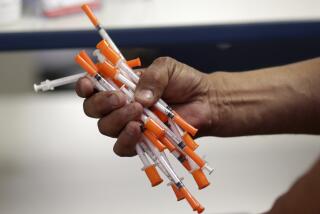Editorial: Gov. Brown, don’t let the feds scare you into vetoing safe injection site
About 72,000 Americans died from drug overdoses in 2017. That’s nearly 200 people per day — more than the number of people killed in car accidents. Fatal overdoses have been on the rise in recent years, due in large part to the proliferation of tremendously dangerous synthetic opioids such as fentanyl, and it’s a safe bet that the daily death rate will be higher again by the end of this year.
This escalating crisis has forced state and local governments to think about new approaches to the problem, including harm-reduction strategies that will help keep people alive and expand treatment options. That has included equipping police officers and emergency medical staff with naloxone, a medication that can reverse opioid overdoses. And thank heaven for that, or the overdose rate would have likely been higher.
Another promising way to reduce fatal drug overdoses is by opening so-called safe injection facilities, where addicts can self-administer illicitly obtained drugs, including heroin and fentanyl, under medical supervision. Dozens of safe injection sites, also known as drug consumption sites, have been operating successfully for years in Europe and Canada, and authorities in a handful of U.S. cities — San Francisco, Seattle and New York, among them — are either considering or planning to open facilities.
We should be doing everything possible to help addicts stay alive.
Last month, the Legislature gave its blessing to a proposal under which San Francisco would be allowed to open one safe injection facility on a three-year trial basis. It was a scaled-back version of a controversial bill that gave the same permission to seven other counties, including Los Angeles. That bill stalled a year earlier after a contentious legislative battle.
The narrower bill is now on the desk of Gov. Jerry Brown. He should sign it, despite the threat leveled by Deputy U.S. Atty. Gen. Rod Rosenstein in an op-ed in the New York Times in August, the day after the Legislature approved the bill.
“Because federal law clearly prohibits injection sites, cities and counties should expect the Department of Justice to meet the opening of any injection site with swift and aggressive action,” Rosenstein wrote.
What a waste of taxpayer money that would be. Sure, it’s a bit strange for government to be in the business of helping people consume drugs. Some people think that it’s immoral to “normalize” drug use that way; others fear that government-sanctioned drug use will merely encourage the problem.
But surely, given the breadth of the problem, its worth a try to see if it reduces deaths.
Despite Rosenstein’s assertions to the contrary (which he bases on one person’s observations and the treatment rate at a year-old safe injection site), there are data showing that the facilities reduce overdoses and direct addicts into treatment. These aren’t dirty drug dens but sterile health facilities staffed with medical professionals who can recognize and reverse deadly overdoses, provide clean needles to reduce infection and help addicts connect with treatment providers. One study of Canada’s first safe injection facility, which has been open since 2003 in Vancouver, found that drug overdoses decreased by 35% in the surrounding community, prompting the Canadian government to develop more such facilities across the country.
Why wouldn’t we at least try out a program with such promise?
Of course, the ideal way to lower fatal drug overdoses is for people to stop using dangerous drugs. But helping people kick opioid addictions requires public investment in treatment options, and often time for treatment to work. Meanwhile, we should be doing everything possible to help addicts stay alive. That’s where harm-reduction strategies such as naloxone, needle exchanges and safe injection facilities can help.
Enter the Fray: First takes on the news of the minute from L.A. Times Opinion »
We hope that Rosenstein’s threat was an empty one, not an indication that the Department of Justice is planning to waste its crime-fighting resources prosecuting social workers and nurses trying to help addicts. Instead, the federal government should be supporting desperate cities and counties as they work to develop strategies to cope with the effects of the overdose crisis.
Happily, Gov. Brown isn’t one to be cowed by federal government bullies when it comes to doing what’s best for Californians.
Follow the Opinion section on Twitter @latimesopinion and Facebook
More to Read
A cure for the common opinion
Get thought-provoking perspectives with our weekly newsletter.
You may occasionally receive promotional content from the Los Angeles Times.






